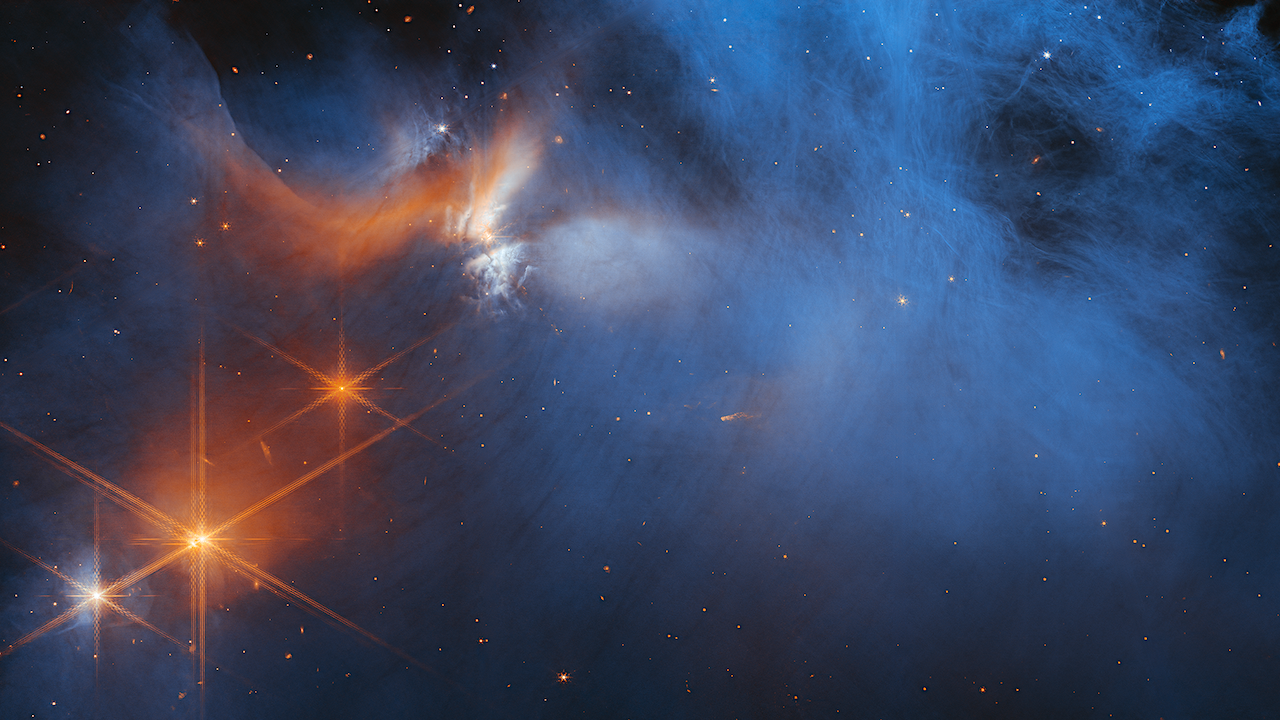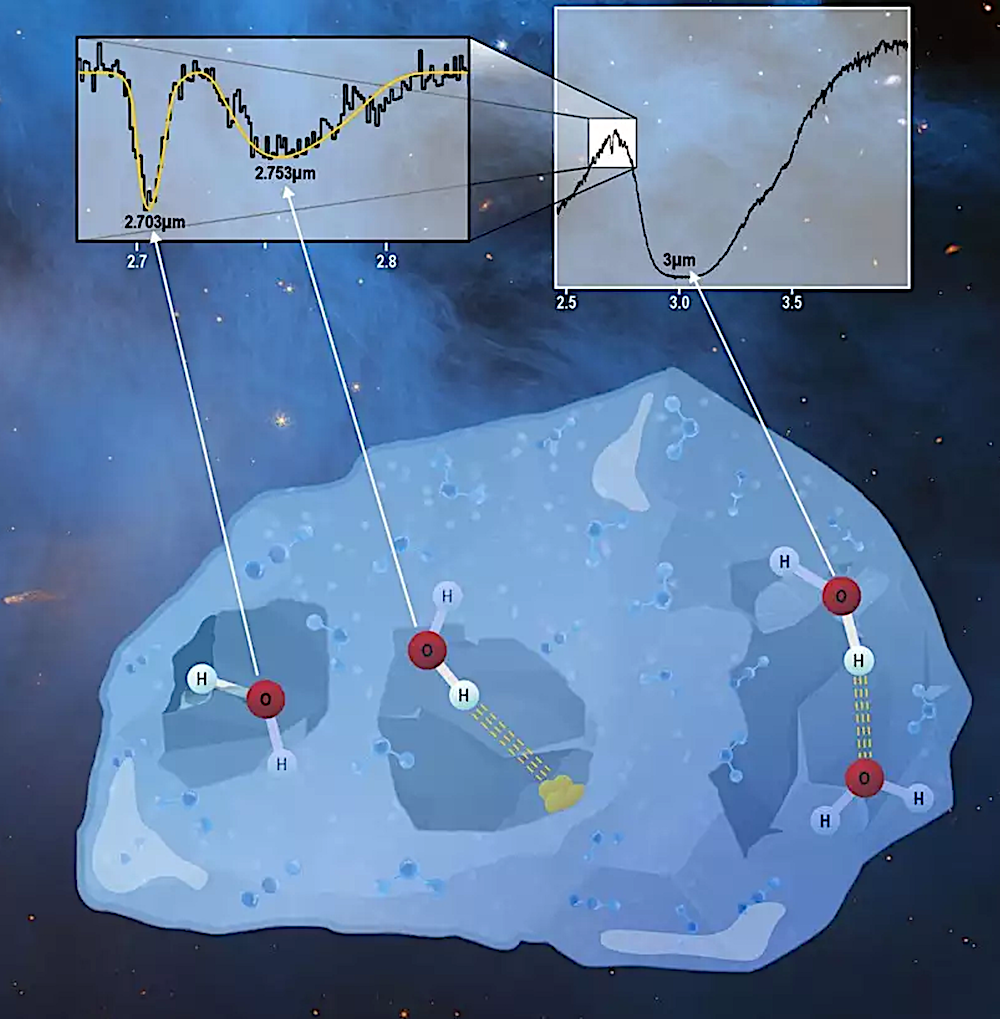
This image from NASA’s James Webb Space Telescope’s Near-Infrared Camera (NIRCam) shows the center of the Chameleon I dark molecular cloud, 630 light-years away. Cool, brilliant cloud material (blue, center) illuminated in the infrared by pink light from the exiting protostar Ced 110 IRS 4 (orange, top left). Light from the abundant background stars, seen as orange dots behind the cloud, is used to detect ice in the cloud, which absorbs starlight passing through them. Big picture
Using JWST, a team of researchers including Paola Caselli, Barbara Michela Giuliano and Basile Husquinet from MPE probed deeper into the dense cloud nuclei, revealing details of the interstellar ice that were previously unobservable. The study focuses on the Chameleon I region using JWST’s NIRCam to measure spectroscopic lines toward hundreds of stars behind the cloud.
For the first time, weak spectroscopic features called 'dangling OH’ have been detected, indicating that water molecules are not fully bound in ice. These features can trace the porosity and transformation of ice grains as they evolve from molecular clouds into protoplanetary disks. The discovery advances our understanding of ice grain structure and its role in planet formation.
JWST’s unprecedented sensitivity allows it to probe deep into dense cloud cores of ice, where destruction is so high that it eluded previous observations. These sight lines are the missing link between the initial formation of ice grains on dust grain surfaces in molecular clouds and the aggregation of ice grains into ice planets, which occurs in the protoplanetary disk around a new star. A deeper look into the origins of stars will provide new clues to these changes in icy grains.
Observations of the densest part of the cloud with JWST’s NIRCam instrument allowed for simultaneous spectroscopic measurements of lines of sight behind hundreds of stars in the Ice Age Project, which targets the Chameleon I region, the densest cloud region closest to us in the Milky Way. the cloud
The light emitted by these stars interacts with ice grains as they pass through the cloud before being captured and detected by JWST’s large mirror. Until now, it has been possible to measure the main, intense absorption features linked to the main species in ice: water, carbon dioxide, carbon monoxide, methanol and ammonia. Thanks to the large size of the telescope mirror, we can now measure very faint features.

Illustration of various OH bonding scenarios observed in dark cloud Cha I with JWST. Three spectral features. © NASA, ESA, CSA and M. Zamani (ESA/Webb); Science: MK McClure (Leiden University), F. Sun (Steward Observatory), Z. Smith (Open University), and The Ice Age ERS team.
Deeper studies of the positions and profiles of weak spectroscopic features reveal certain physical states of matter. Here, we are the first to identify a specific set of very weak bands connected to only a small fraction of the water molecules in ice.
The spectroscopic features, dubbed 'dangling OH’ by laboratory astrophysicists who have measured them in laboratory ices for decades, correspond to water molecules not fully bound within the ice, and can be detected within ice grains or at water surfaces and interfaces. It is intimately mixed with other molecular species in ice.
The 'hanging OH’ features are in a spectral region inaccessible from the ground, so they have been intensively searched for since the 1990s, when previous space observatories covering that spectral range lacked the necessary combination of spectral resolution and sensitivity to detect them. They only provide upper bounds. Now in the JWST era, these signatures can be used to trace ice grain changes on the journey to planet formation.
If detected, these signatures can be used to determine the porosity of the ice sheets, meaning that their presence indicates 'spongy’ grains with high porosity, while their absence indicates compaction and agglomeration. Although this simple explanation remains under debate, the successful detection of these signatures means that we can now look for them in different environments and at different times during star formation. Formed under different conditions.
„Finding a water-suspended binding feature in ice sheets demonstrates the importance of laboratory astrophysics for interpreting the JWST data,” says Barbara Michaela Giuliano, one of the authors. „Detailed information on the physical properties of the observed ices requires extensive support from the laboratory to disentangle the spectral features observed in dense regions of the interstellar medium and protoplanetary disks. Here at CAS we are pleased to provide such support,” he adds.
„JWST’s high sensitivity, combined with impressive advances in laboratory astrophysics, finally allows us to study the physical structure and chemical composition of interstellar ices in detail. This should provide tight constraints on the chemistry/dynamics modeling needed to reconstruct our astrochemical history, from galactic clouds to protoplanetary disks to star systems like ours. Very important. It’s exciting to be part of this effort”, says Paola Caselli, who – together with her PhD student Basil Haskinet – contributed to the article.
The study shows that in the cloud, there are 'fluffy’ ice grains, which affect the chemistry that can occur in these regions, leading to the formation of a high degree of chemical complexity. The discovery opens a new window on planet formation and, ultimately, allows us to develop an idea of the spatial distribution and variability of these spectral features of ices and how they form on their journey from molecular clouds to protoplanetary disks to planets. .
Detection of elusive hanging OH ice features at ~2.7 μm in Chamaeleon I with JWST NIRCamNature
Astronomy, Astrophysics,

„Oddany rozwiązywacz problemów. Przyjazny hipsterom praktykant bekonu. Miłośnik kawy. Nieuleczalny introwertyk. Student.
